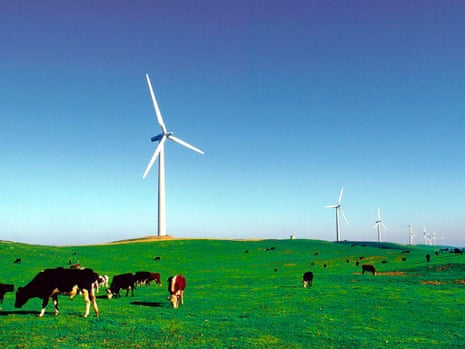Cutting the renewable energy target could bankrupt existing wind farms and lead to legal action against the commonwealth government, energy companies have warned.
The government has long been divided over whether to pare back the scheme or close it down to all new entrants – the two options being considered by its review, headed by the businessman and self-professed climate sceptic Dick Warburton. The review delivered its report on Friday.
Supporters of the “paring back” plan, understood to include environment minister Greg Hunt, have presented the “paring back” option as a compromise plan, which would allow some new investment and existing projects to continue, and would also have a better chance of passing the senate because it could be argued that it was in line with the original intent of the RET policy.
The plan is also supported by fossil fuel energy companies whose profits would be boosted by at least $10bn by the policy, according to new research.
But some parts of the renewable industry says paring back the RET would be almost as devastating to their existing investments – made at a time of clear bipartisan support for a RET targeting 41,000 gigawatt hours of renewable energy by 2020.
The “paring back” option would also devastate the solar PV and solar hot water industries, according to the Solar Council, which has begun a marginal seat campaign to rally support.
The campaign begins with a public meeting in the Liberal’s most marginal seat of Petrie on Thursday night, but local MP Luke Howarth, who was consulted before the meeting date was set, is now not attending. Guardian Australia understands the government has taken a decision that local members should not attend the rallies.
Howarth told the Courier Mail “we’re not slashing the RET at all it’s just plain false” and told Guardian Australia last month he was a big supporter of solar power and renewable energy. “There are obviously mixed feelings about it, but I think renewable energy is a good thing,” he said.
But the Solar Council says even the “paring back” option would cost 8,000 jobs.
And according to Miles George, the chief executive of Infigen, which has invested $1.2bn in Australian renewable projects, even the “mild” option of paring back the RET would drastically reduce the value of the renewable energy certificates that are traded on the market created by the renewable energy target.
“If you lower the target the value of renewable energy certificates will remain very depressed. Investments have been made on price assumptions based on what was bipartisan policy. If you lower the target their value will be enormously depressed. Without some specific policy to protect existing investments, that means it will only take a short time before our debt covenants kick in and we will go bankrupt,” George said.
“Of course we would look at our legal options if that happened, we have a responsibility to our shareholders. That is exactly what happened in Spain when they retrospectively changed policy.”
Pacific Hydro spokesman Andrew Richards said reducing the RET would but renewable businesses “under duress”.
“Reducing the RET will reduce renewable energy certificate prices by between 50% and 60%. Investments have been based on the previous bipartisan policy, so existing assets that have not got long term contracts will be under extreme duress and other assets will be under duress when they have to refinance – that is almost the dictionary definition of sovereign risk.”
Andrew Thomas, chief executive of Acciona, said the impact would depend on the policy detail, but if companies did not have long term power supply contracts “some existing assets could come under extreme pressure and whether companies can withstand that or not is the question”.
The option of closing the scheme to new entrants was widely seen as having the most support in government, including long standing and strong support from the prime minister, but Hunt, is understood to have favoured paring back the RET.
After the Palmer United party said in June that it would not pass any changes to the RET in this term of government, the “paring back” option gained ground as more politically realistic, because it could be argued the original intent of the policy was to deliver 20% of energy from renewables by 2020. Because of falling electricity demand, the RET’s designated 41,000 gigawatt hours will represent closer to 28% if the policy is left unchanged.
Palmer reiterated on Monday that he would not support any changes to the scheme during this parliament.
As well, several modelling exercises – including one done for the review itself – showed that closing the RET to new entrants would not reduce electricity prices, which was the reason given by the prime minister for reviewing the program in the first place.
“We have to accept that in the changed circumstances of today, the renewable energy target is causing pretty significant price pressure in the system and we ought to be an affordable energy superpower … cheap energy ought to be one of our comparative advantages,” Abbott said last year.
But according to sources, as the review process reached its conclusion and began providing briefings to the prime minister’s office, with the “paring back” option appearing to be the most likely, the office intervened to insist on more work on the policy of closing the RET to new entrants.
If it was reduced to a “real 20%” under the “paring back” option it would deliver around 25,000 gigawatt hours. If it was closed to new entrants it would deliver 17,000 gigawatt hours.
